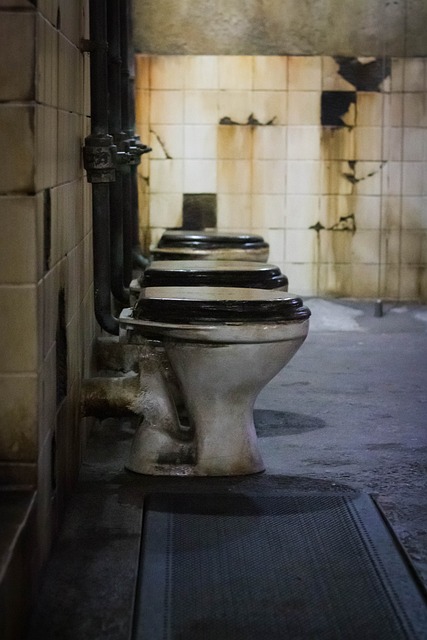Toilet installation requires thoughtful planning for a successful renovation. Understanding various toilet types, from traditional to modern low-flow models, ensures selection aligns with space, efficiency, and comfort needs. Key steps include assessing bathroom dimensions, evaluating plumbing systems, and choosing a suitable toilet style (round front, elongated, compact). Initial preparation guarantees a proper fit and long-term functionality. Installation involves removing the old toilet, preparing the new one, securing it firmly, connecting water lines, and adjusting height. Post-installation checks are crucial for efficiency and longevity. Avoiding common mistakes like improper leveling and inadequate clearance ensures stability, optimal performance, and easy maintenance.
“Transform your bathroom with a new toilet installation—a simple upgrade with significant impact. From space assessment to final fitting, this comprehensive guide navigates every step of the process. Discover the diverse toilet types and styles available, learning how to choose the perfect suite for your needs. Understand essential preparation, from plumbing checks to measuring your space accurately.
Master the installation process with our detailed, step-by-step instructions, ensuring a seamless fit. Post-installation, learn vital maintenance tips and avoid common mistakes that could disrupt your new toilet’s performance.”
Understanding Toilet Types and Styles for Installation

When it comes to toilet installations, understanding the diverse range of toilet types and styles is crucial for a successful and efficient bathroom renovation. From traditional gravity-fed toilets to modern low-flow models, each design offers unique features catering to various user needs and preferences. For instance, while gravity-fed toilets are common in residential settings due to their cost-effectiveness and reliability, they rely on water pressure to flush waste. In contrast, low-flow or dual-flush toilets are gaining popularity for their water conservation capabilities, especially in areas with water scarcity.
Additionally, toilet styles vary significantly, from sleek, contemporary designs that enhance bathroom aesthetics to classic, traditional models that exude timeless elegance. Some popular styles include round front, elongated, and compact toilets, each with its own dimensions and features. Choosing the right toilet type and style not only ensures a seamless fit in your bathroom but also contributes to a comfortable and functional space. Consider factors like water efficiency, ease of cleaning, and personal comfort during the installation process for optimal results.
Preparation: Assessing Your Bathroom Space and Plumbing System

Before starting a toilet installation, thorough preparation is key. Begin by assessing your bathroom space – measure the area to ensure the new toilet fits comfortably without obstructing circulation or other fixtures. Check your plumbing system to verify its capacity and condition; older systems might need upgrades to support modern toilets, which can vary significantly in water usage and waste processing capabilities.
This initial evaluation helps in selecting a suitable toilet that aligns with both your space constraints and environmental considerations. It’s also wise to consult with a professional if you’re unsure about the feasibility or have complex plumbing layouts. Proper preparation ensures a smoother installation process and enhances the likelihood of long-term functionality, saving you potential future headaches and costs associated with toilet replacements.
Choosing the Right Toilet Suite: Factors to Consider

When considering a toilet installation, choosing the right toilet suite is paramount. Several factors come into play to ensure a functional and aesthetically pleasing space. First, toilet installation involves matching the toilet’s style, size, and design with your bathroom’s overall aesthetic and available space. The right fit ensures optimal comfort and ease of use for occupants.
Second, consider water efficiency and sustainability. Modern toilets come with various flushing mechanisms designed to reduce water consumption without compromising performance. High-efficiency models can save significant amounts of water over time, aligning with environmental concerns. Additionally, understanding the plumbing setup and local regulations is crucial before toilet installation to avoid unforeseen issues or costly repairs down the line.
Step-by-Step Guide: Installing a New Toilet

Installing a new toilet is a relatively straightforward process that can be accomplished with the right tools and some basic DIY skills. Here’s a step-by-step guide to ensure a smooth and successful Toilet Installation:
1. Remove the Old Toilet: Start by turning off the water supply to your toilet, usually located behind the toilet or under the sink. Then, use a wrench or a toilet removal tool to carefully take apart the old toilet, lifting it out of the bowl. Clean the existing bowl and floor thoroughly before proceeding.
2. Prepare the New Toilet: Unpack your new toilet and lay it flat on its side to inspect all parts. Ensure all components are intact and in good condition. Place the toilet over the cleaned bowl with the flange (the circular seal) aligned perfectly in the middle. Secure the toilet firmly in place by tightening the bolts provided, making sure they are snug but not overly tight.
3. Connect Water Lines: Identify the water lines connected to your old toilet and prepare them for reconnection. Turn on the water supply and test for any leaks. Connect the new toilet’s water lines, ensuring a secure fit. Double-check all connections by turning on the water again.
4. Adjust and Level the Toilet: With the water lines connected, adjust the toilet’s height as needed using the adjusting screws under the toilet seat. Ensure it is level and aligned correctly with the floor. Once satisfied with the positioning, install the toilet seat and lid securely.
Post-Installation Checks and Maintenance Tips

After a successful toilet installation, conducting thorough post-installation checks is essential for ensuring optimal performance and longevity of your new fixture. Start by verifying the water supply connections; turn on the valves and check for any leaks or drips around the base. Ensure the flush mechanism operates smoothly and efficiently, aiming for a balanced water distribution during each flush. Inspect the toilet’s alignment, making sure it is level and securely fastened to the floor. This step is crucial to prevent future wobbling or instability.
Regular maintenance plays a vital role in keeping your newly installed toilet in top condition. Regularly clean the bowl and rim with appropriate cleaners to remove stains and buildup. Pay special attention to the flush valve and chain mechanism, as these components require periodic lubrication to ensure smooth operation. Additionally, check for any signs of water damage or mold growth behind the toilet regularly. Addressing these issues promptly will save you from more extensive repairs down the line, ensuring a seamless and hygienic bathroom experience.
Common Mistakes to Avoid During Toilet Setup

When setting up a new toilet, many homeowners make common mistakes that can lead to future issues and costly repairs. One of the most frequent errors is improper leveling, which can cause the toilet to rock and create a messy water line. Always ensure the toilet base is level before securing it in place. Neglecting this step may result in water damage and an unstable fixture.
Another blunder is inadequate clearance around the toilet, especially in tighter spaces. It’s crucial to allow for proper circulation and ease of cleaning. Insufficient clearance can make cleaning challenging and might lead to clogs or water leaks. Always measure and plan accordingly, ensuring there’s enough space for maintenance and the toilet’s functionality.
